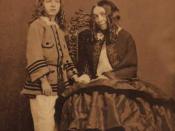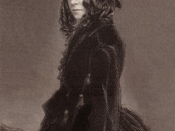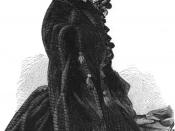We live in a constantly expanding industrial society. Though there are certainly obvious benefits to this lifestyle, particularly in the realm of medicine and technology, industrialization has long been the subject of anxiety and debate in society, particularly during the years surrounding the Industrial Revolution. Of particular interest was its effect on the human condition. In both the short story "Odour of Chrysanthemums" by D. H. Lawrence and "The Cry of the Children" by Elizabeth Barrett Browning, the authors use the contrast between nature and industry to illustrate the various ways in which industry greatly worsens human lives on a psychological level.
To begin, Lawrence and Browning both use their pieces to show that industrialization leads to a lack of freedom in human lives. In both stories, nature is seen to represent freedom, and is placed in stark contrast with modern, industrialized life. "The Cry of the Children" depicts the harsh and hopeless lives of child labourers with brutal detail.
It begins with vivid and pleasant imagery of an idyllic nature scene: "The young lambs are bleating in the meadows/ The young birds and chirping in the nest / The young fawns are playing with the shadows / The young flowers and blowing toward the west." Browning immediately establishes a connection between happiness and nature, showing young animals playing and being joyful. The difference between this scene and the lines that follow could not be more obvious: "The young, young children [â¦] they are weeping in the playtime of the others/ In the country of the free." Browning makes this contrast brutally clear: the children, unlike the animals that live in nature, live lives of slavery, not freedom, and are thus miserable. D. H. Lawrence illustrates this same phenomenon very literally in "Odour of Chrysanthemums." He depicts the life of a miner as dull, joyless, and trapped by routine: we see that it is a regular occurrence for the protagonist's miner husband to come home late from work and spend his money getting drunk at a pub. "Aye, it's a nice thing, when a man can do nothing with his money but make a beast of himself!" the miner's father-in-law states bitterly. It is clear that he is unhappy and uses alcohol as a form of escapism; the fact that he is trapped in his life is mirrored very obviously by Lawrence when the miner is trapped in a cave-in at his job. Quite literally, his industrial line of work traps him.
It is also made clear in both pieces that industry causes great unhappiness and melancholy in human lives. This is particularly evident in "The Cry of the Children", which shows how miserable and hopeless child labourers are: "All day, the iron wheels go onward/ Grinding life down from its mark." There is no room for happiness in the lives of child slaves. It is evident that they have lost all hope- even religious faith is gone from them. "Is it likely God, with angels singing 'round Him/ Hears our weeping any more?" they ask, before claiming that "He is speechless as a stone" in the face of their misery. Once again, Browning uses nature imagery to illustrate her point: she calls for the children to "Go out [â¦] from the mine and from the city/ Sing out [â¦] as the little thrushes do/ Pluck your handfuls of the meadow-cowslips pretty." Contrasted against the happiness and freedom of nature, the darkness of the children's lives seems all the more unbearable. In "Odour of Chrysanthemums", we learn that the miner's lonely and dull life lead to emotional isolation and a lack of human connection between his wife, even while they both maintained the illusion of a loving relationship. Standing over his dead body, his wife reflects on their relationship: "And she knew what a stranger he was to her [â¦] There had been nothing between them, and yet they had come together, exchanging their nakedness repeatedly. Each time he had taken her, they had been two isolated beings, far apart as now." Lawrence reflects this unhappiness in his depiction of the plants near the house: "The fields were dreary and forsaken [â¦] There were some twiggy apple trees, winter-crack trees, and ragged cabbages." Seen next to the powerful locomotive which moves "with loud threats of speed", these plants seem particularly pitiful. The weakness of nature is used as an allegory to the melancholy of the individual in the face of industry.
Finally, Lawrence and Browning both show that industry eventually causes the death of humans, either literally or spiritually via a loss of will to live. In "Odour of Chrysanthemums", the miner is literally killed by his job when he becomes trapped in a cave-in. This event stands as Lawrence's grisly warning against the negative effects of industrialization on human life. The miner's death is symbolized by the titular chrysanthemums, a vase of which rests in the house. The miner's wife tells their daughter that her husband always brought her chrysanthemums to celebrate important events in her life; in this sense, the chrysanthemums stand as a symbol or reminder of the miner himself. When the miner's corpse is brought back to his home, we are told that there was "a cold, deathly smell of chrysanthemums" in the room, which clearly represents the death of the miner.
Browning also shows the death of humans due to industrialization, but her concept of death is more psychological than literal. In "The Cry of the Children," she shows that the miserable existence of child slaves has led them to completely give up on life. "Alas, alas, the children! They are seeking / Death in life," she says, describing how even if the slaves could get a chance to play and enjoy life by "Sing[ing] out [â¦] as the little thrushes do" or by "plucking [their] handfuls of the meadow-cowslips pretty", they would be too exhausted to do so. Indeed, the children themselves say that "it is good when it happens [â¦] that we die before our time." Thus does she make her point quite clear: though the child labourers are not literally dead, they have been psychologically killed by industrialization.
It is thus clear that both D. H. Lawrence and Elizabeth Barrett Browning use the contrast of the natural and industrial worlds to show that industry causes a lack of freedom, great melancholy, and death. Industrialization has long been synonymous with progress, but these two authors want us to consider that perhaps true progress would actually involve taking steps away from industrialized society.
BIBLIOGRAPHY"Odour of Chrysanthemums" by D. H. Lawrence"The Cry of the Children" by Elizabeth Barrett Browning





